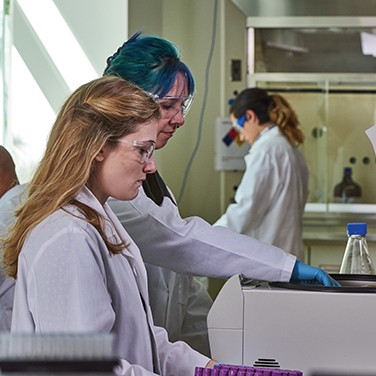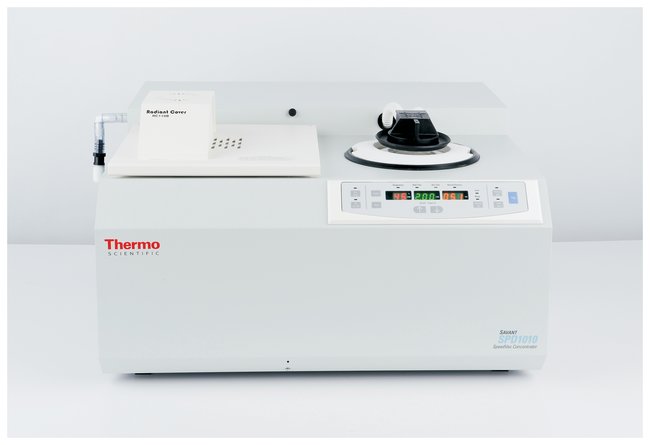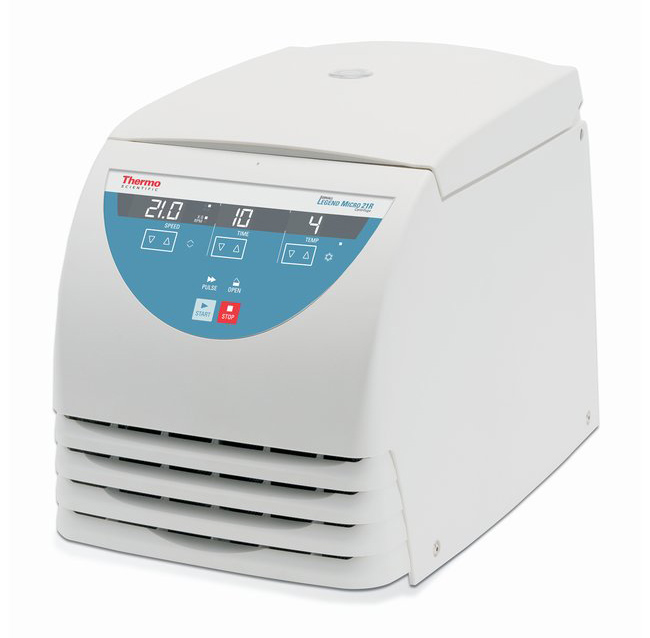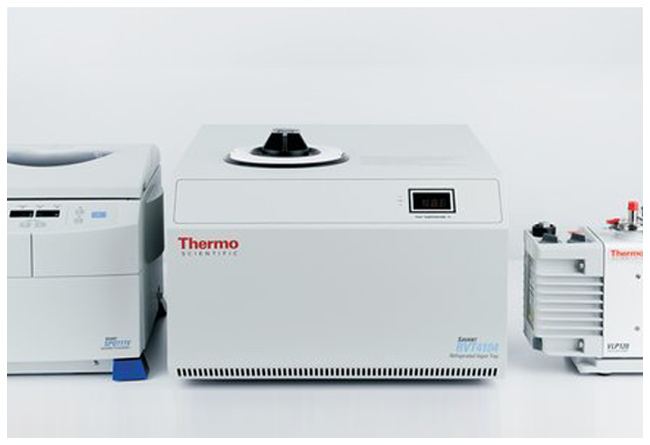Increase Your Proteomics Workflow Efficiency
Increase Throughput, Protect Samples
Solvent removal is often the limiting step in a proteomics process and can affect the overall throughput in a laboratory. While there are several methods for removing solvent, vacuum centrifugal concentration is the method of choice.
With this method, centrifugation minimizes violent boiling (“bumping”) that may cause sample loss and cross contamination between vessels. The boiling point of the solvent is reduced by the vacuum; solvent evaporation also removes heat and causes sample temperatures to drop significantly. The application of heat to the system counteracts these cooling effects and speeds the drying process.
Researchers may be reluctant to use heat in vacuum concentration because of concerns about viability of the product. Continued heating after the evaporation is complete will raise the temperature of the remaining sample and can cause thermal degradation.
The Thermo Scientific Savant family of vacuum concentrators offers different models for this application. The model selection will depend on the type of solvents and format being used.
For a medium capacity system, the Savant vacuum concentrator kit SPD111V P1 is recommended. For larger capacity samples, two different systems can be used depending on your needs. The Savant SPD1010P1 is an integrated system with a built-in vacuum pump; the Savant SC250 EXP P1 is a modular system.
Enrich Protein Samples
Immunoblotting allows the precise identification of the electrophoretic band for a particular protein in complex samples. The total amount of protein loaded per gel lane is limited, which in turn restricts detection of low-abundance proteins1.
Membrane proteins in particular may be concentrated by isolation of the membrane fraction of cell lysates by centrifugation in a Thermo Scientific Sorvall Legend Micro 21R Microcentrifuge. A membrane fraction suitable for analysis by immunoblotting can be obtained from by centrifugation at 15,000-21,000xg for 1-2 hours at 40°C, depending on the sample type.
Compared with other routine methods of cell lysate preparation (such as boiling in the regular SDS electrophoresis sample buffer after breaking cells with glass beads or after alkaline treatment) centrifugation may produce better immunoblotting results for membrane-associated proteins.
Preserve Samples, Save Energy
Storing biological samples in an ultra-low temperature (ULT) freezer set at -80°C is something of a laboratory custom: lab personnel will even refer to their ULT freezer simply as the “minus 80”. But, raising your freezer cabinet temperature by just 10°C can lead to significant energy savings which, as every laboratory manager knows, can have a huge impact on both energy consumption and environmental footprint.
Most biological material does not have to be kept at -80°C. Proteins, as well as nucleic acids, bacteria and viruses will remain fully viable when stored at -20°C or -70°C (depending on the intended duration of storage).
Many laboratories today are seeking ways to reduce energy expenditure. Not only does this reduce the impact that the research may be having on the environment, but also reduces the associated energy costs, which can be especially high for continuously running equipment like freezers. While increasing the freezer set point to -70°C can reduce energy usage by up to 30%, ensuring that your lab is outfitted with the most up-to-date equipment is also important. Manufacturers are responding to ever increasing regulations with technological advances to ensure that systems operate more efficiently, and are manufactured in a more environmentally friendly manner.
By using this higher temperature set point, you can substantially reduce energy costs, and by choosing freezers that use natural, SNAP-compliant2 refrigerants, your lab will ultimately be responsible for fewer greenhouse gas emissions, and will help to contribute to the preservation of the environment and the continuation of sustainable science.
1) A simple enrichment procedure improves detection of membrane proteins by immunoblotting; Azamat Karginov and Michael Agaphonov, Bach Institute of Biochemistry, Research Center of Biotechnology of the Russian Academy of Sciences BioTechniques 61:260-261 (November 2016)
2) United States Environmental Protection Agency (EPA) Significant New Alternatives Policy (SNAP)

Shop Thermo Scientific Proteomics Products
 Thermo Scientific™ Savant™ SPD1010 and SPD2010 SpeedVac™ Kits |
 Sorvall™ Legend™ Micro 21R Microcentrifuge |
 Thermo Scientific™ Savant™ SPD111 SpeedVac™ Kits |
